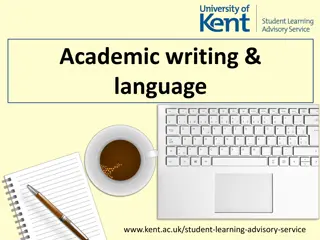Mastering Minute-Taking in Technical Writing: Essential Skills and Strategies
Enhance your minute-taking skills with this detailed guide covering the role of a minute-taker, preparing for meetings, setting agendas, the importance of active listening, tips for effective note-taking, structuring minutes, and the overall goals of minute-writing. Learn how to be concise, accurate, and objective to produce impactful meeting records.
Download Presentation

Please find below an Image/Link to download the presentation.
The content on the website is provided AS IS for your information and personal use only. It may not be sold, licensed, or shared on other websites without obtaining consent from the author.If you encounter any issues during the download, it is possible that the publisher has removed the file from their server.
You are allowed to download the files provided on this website for personal or commercial use, subject to the condition that they are used lawfully. All files are the property of their respective owners.
The content on the website is provided AS IS for your information and personal use only. It may not be sold, licensed, or shared on other websites without obtaining consent from the author.
E N D
Presentation Transcript
MINUTE-TAKING BA III ENGLISH (Technical Writing) SEC 301
WHAT WELL COVER THIS EVENING The minute taker s role Listening Capturing what s said Writing up and structuring minutes
THE WEIRD LANGUAGE OF MEETINGS Formal Informal Everyday
the minute the minute- -taker s task taker s task Before Meeting During Meeting After Meeting Preparation Writing down actions and conclusions Distributing the minutes
MEETING PREPARATION Organising the meetings Inviting participants Setting the agenda
SETTING THE AGENDA Producing the agenda (with the Chair) It sets clear objectives It provides pre-meeting information It includes all relevant items It shows the structure and timing of the meeting It shows who is required
THE IMPORTANCE OF LISTENING Stay focused on the speaker Don t tune out dry-sounding information Try not to evaluate as you are listening Show you are actively listening Ask clarifying questions Don t interrupt Brain Vs Ears
TIPS FOR TAKING NOTES Draw up a table plan Print off an agenda for you to write notes against with big spaces Record the action to be taken clearly and the date when it s to be done by
WRITING UP MINUTES Take notes during the meeting, write minutes up afterwards Do it soon!
WHAT YOURE AIMING FOR 1. 2. Background Discussion Decision Action 3. 4. Whilst being: authentic, complete, concise, free from ambiguity, in the past tense
THE STRUCTURE OF MINUTES Beginning Middle End
BEGINNING Heading Attendance Present In attendance (i.e. not a member of the committee) Apologies Absent Item 1: Previous Minutes Item 2: Matters arising from the previous minutes
MIDDLE Item 3. Business Go through in order of the agenda (keep the same numbering) Make a record of what was said E.g. a brief outline of the discussion and actions agreed or Just a record of the actions [in bold, with initials of who is responsible]
END 4. AOCB 5. Date of next meeting Chairperson s name and date
THE POWER OF WORDS How you minute conversations can subtly change how the reader interprets the minutes: Use They Past Tense: said, stated, argued, contested, emphasised, reinforced, stressed, urged, declared, mentioned
ONCE MINUTES COMPLETED Distribute quickly: 80:20 rule File them safely somewhere paper and electronic?
THANK YOU! THANK YOU!























